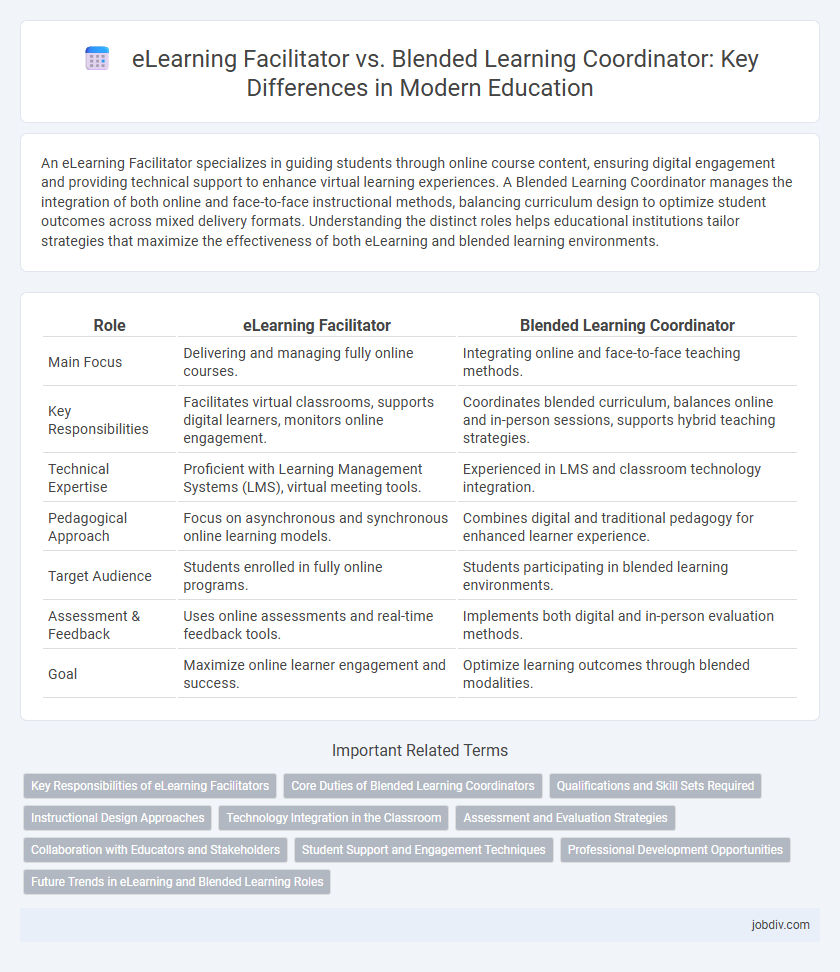An eLearning Facilitator specializes in guiding students through online course content, ensuring digital engagement and providing technical support to enhance virtual learning experiences. A Blended Learning Coordinator manages the integration of both online and face-to-face instructional methods, balancing curriculum design to optimize student outcomes across mixed delivery formats. Understanding the distinct roles helps educational institutions tailor strategies that maximize the effectiveness of both eLearning and blended learning environments.
Table of Comparison
| Role | eLearning Facilitator | Blended Learning Coordinator |
|---|---|---|
| Main Focus | Delivering and managing fully online courses. | Integrating online and face-to-face teaching methods. |
| Key Responsibilities | Facilitates virtual classrooms, supports digital learners, monitors online engagement. | Coordinates blended curriculum, balances online and in-person sessions, supports hybrid teaching strategies. |
| Technical Expertise | Proficient with Learning Management Systems (LMS), virtual meeting tools. | Experienced in LMS and classroom technology integration. |
| Pedagogical Approach | Focus on asynchronous and synchronous online learning models. | Combines digital and traditional pedagogy for enhanced learner experience. |
| Target Audience | Students enrolled in fully online programs. | Students participating in blended learning environments. |
| Assessment & Feedback | Uses online assessments and real-time feedback tools. | Implements both digital and in-person evaluation methods. |
| Goal | Maximize online learner engagement and success. | Optimize learning outcomes through blended modalities. |
Key Responsibilities of eLearning Facilitators
eLearning Facilitators primarily design and deliver online instructional content, ensuring an engaging and interactive virtual learning environment through multimedia tools and digital platforms. They monitor student progress, provide timely feedback, and address technical challenges to enhance learner outcomes in fully remote settings. Their role contrasts with Blended Learning Coordinators, who integrate both face-to-face and digital instruction, focusing on curriculum alignment and hybrid classroom management.
Core Duties of Blended Learning Coordinators
Blended Learning Coordinators primarily design and implement hybrid instructional models that combine online digital media with traditional classroom methods to enhance student engagement and learning outcomes. Their core duties include managing the integration of technology, conducting professional development for educators, and continuously evaluating the effectiveness of blended learning programs. They also collaborate with teachers, administrators, and IT staff to ensure seamless delivery and alignment with curriculum standards.
Qualifications and Skill Sets Required
An eLearning Facilitator requires strong expertise in digital instructional design, proficiency with learning management systems (LMS), and the ability to engage learners through virtual communication tools. In contrast, a Blended Learning Coordinator must combine skills in both online and face-to-face educational methods, project management, and collaboration with faculty to integrate technology with traditional teaching. Both roles demand excellent organizational skills and a solid understanding of pedagogical theories to optimize learner outcomes.
Instructional Design Approaches
eLearning Facilitators primarily implement online instructional design models such as ADDIE and SAM to create interactive digital content tailored for virtual learners, emphasizing adaptability and learner engagement. Blended Learning Coordinators integrate face-to-face and online pedagogies using frameworks like the Community of Inquiry and flipped classroom models, ensuring seamless transitions between modalities for comprehensive skill development. Both roles leverage multimedia tools and learner analytics to customize instruction, but Coordinators emphasize synchronizing diverse delivery methods to optimize educational outcomes.
Technology Integration in the Classroom
An eLearning Facilitator specializes in implementing digital tools and platforms to enhance online learning experiences, ensuring seamless technology integration for remote or asynchronous education. In contrast, a Blended Learning Coordinator strategically combines face-to-face instruction with digital resources, optimizing classroom technology use to create interactive, hybrid learning environments. Both roles require expertise in educational technology, but the eLearning Facilitator emphasizes virtual instruction while the Blended Learning Coordinator focuses on merging traditional and digital methods.
Assessment and Evaluation Strategies
An eLearning Facilitator primarily designs and implements online assessment tools such as quizzes, interactive assignments, and real-time feedback systems to gauge student understanding in virtual environments. A Blended Learning Coordinator integrates both digital and face-to-face evaluation methods, combining formative assessments during in-person sessions with summative online tests to provide a comprehensive understanding of learner progress. Both roles emphasize data-driven decision-making, using analytics from learning management systems to refine instructional strategies and improve educational outcomes.
Collaboration with Educators and Stakeholders
An eLearning Facilitator actively collaborates with educators and stakeholders by designing interactive online modules and providing training to integrate digital tools effectively into curricula. In contrast, a Blended Learning Coordinator works closely with teaching staff and administrators to balance in-person and online instruction, ensuring seamless curriculum alignment and resource sharing. Both roles emphasize partnership, but the eLearning Facilitator focuses on virtual engagement strategies while the Blended Learning Coordinator prioritizes hybrid learning ecosystem management.
Student Support and Engagement Techniques
An eLearning Facilitator employs digital tools and virtual communication strategies to enhance student support and engagement, such as interactive webinars, real-time feedback, and online discussion forums. A Blended Learning Coordinator integrates both online and face-to-face instructional methods, focusing on personalized learning plans, in-class collaboration, and technology-enhanced activities to maintain active student participation. Both roles prioritize adaptive feedback and inclusive communication to foster student motivation and successful learning outcomes.
Professional Development Opportunities
eLearning Facilitators often engage in specialized professional development focusing on digital tools, instructional design, and virtual engagement strategies to enhance online learning experiences. Blended Learning Coordinators benefit from training that integrates face-to-face and digital methodologies, emphasizing curriculum design, technology integration, and classroom management techniques. Both roles require ongoing skill advancement through workshops, certifications, and collaborative learning networks to stay current with evolving educational technologies.
Future Trends in eLearning and Blended Learning Roles
Emerging trends in eLearning highlight the growing demand for eLearning Facilitators skilled in virtual engagement and adaptive learning technologies, ensuring personalized online experiences. Blended Learning Coordinators increasingly integrate digital and face-to-face instruction, leveraging data analytics to optimize hybrid curriculum effectiveness. The future role landscape emphasizes collaborative tools, AI-driven content customization, and continuous professional development to meet diverse learner needs across platforms.
eLearning Facilitator vs Blended Learning Coordinator Infographic

 jobdiv.com
jobdiv.com